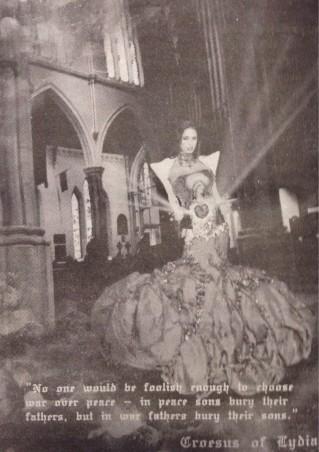By Miranda Beninger
“The Premonition of War” is one of 47 collections presented by fourth-year fashion design students at this year’s Mass Exodus fashion show on April 8 and 9. Inspiration for the collection came when fourth-year fashion student Lucien Matis worked at a factory in Kitchener, Ont. during the summer.
“It was very dark and dreary in the factory. The noises, and the metal. Being there in the summer inspired me a lot,” he said.
Matis’ collection has many political and religious undertones. One of the garments taking to the runway resembles a gun. Another shirt can open up to reveal a colourful beaded image of Madonna. Matis hopes to make a statement with this collection.
“The world is very crazy right now,” he said.
Matis worked day and night to complete the five pieces that make up the collection. He began sewing in November and it took him about a month to complete each piece.
“Fashion lets me explore art, makeup, photography, design and sewing,” he said.
Matis and other fourth-year fashion design students have been working since September on their designs for their final project. They proposed business plans to their teachers and have worked with theatre tech and fashion communications students to bring the show together.
Jenn Sharpe, a fourth-year fashion communications student, is this year’s show director. About 50 third and fourth-year fashion communications students planned the show as part of a required course that began in September. Instead of the regular three shows this year, a fourth has been added so Ryerson students can attend.
“In the past, the three shows have sold out, so we added another,” said Sharpe.
One show will be for press and industry people. For the designers, the show is an opportunity to invite potential employers to see their work. Each students was given two invitations to send to anyone in the industry.
The Ryerson School of Fashion began its shows in the 1950s as small in-house presentations of student work. The concept grew over the years and the show has been held in hotels around the city before relocating to the Ryerson Theatre in the 1980s.
In choosing the title and theme for this year’s show, Kiss the Hem,” students took into consideration the current fashion trends in the market as well as political and economic factors affecting the fashion industry.
Sharpe said this year will show diversity and creativity, including a new maternity line. The other lines include eveningwear, children’s wear and menswear. Just under 100 models will participate in the show this year, attracting students, faculty, photographers and fashion industry members to see the designs of the students.
Fashion communications students put together all aspects of the show, including choreography, Website design, fundraising, music and script.
Maria Mak, a fourth-year fashion student, hopes her “Jane in the City” collection gets her name known in the industry, and helps her land a job after graduation. Her collection features mostly leather and furs. Mak is using fox and beaver as well as wool and silk as her medium. She hopes to target an audience of younger, urban women.
“They will have the money to buy the furs,” she said.
Mak said she did not keep track of how much money she spent making her collection, but says the figures were over a few thousand dollars. She bought the leather from stores on Queen Street and purchased the fox and beaver from furriers.
“I probably spent more than some students did, but it all depends on what you’re going for,” she said. Many of Mak’s fashions also experiment with buckles and reversible clothing for versatility.
Joyce Shan, another fourth-year fashion student participating in the show, handsewed 15 pounds of beads onto one of the dresses in her collection, “The Flamingo Flamenco.” She describes the collection as ‘shocking,’ very eye-catching, and positive. Her colour scheme is bright, with combinations of pink, orange, turquoise and blue.
“For the summer, beads are very in style. And so I wanted to incorporate this trend into my collection. The whole thing is a lot of handwork,” said Shan.
“The hardest part is that it’s my first time doing couture. The hem basting takes a long time and there are many layers and hand stitches,” she said.
While many students are looking to sell their collections, Shan said that she will keep hers. Even though they are not her size, she said they represent all the hours of har work she put in. “They’re like my babies!” she said.
Another crucial aspect in the running of the show are volunteers, according to Lewis.
“Mass Exodus just can’t run without volunteers. Our volunteers include dressers, ushers, whoever we can get,” said Lewis.
“It’s a challenging thing to work out, and make it all come together,” she said. “There’s just never enough time.”











Leave a Reply